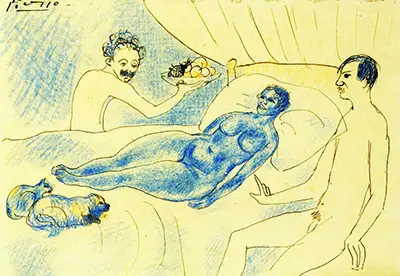This quickly identifies the artwork as one from the artist’s Blue Period. The work features Sebastià Junyer i Vidal who was one of the artist’s friends. Picasso also featured Junyer in other works during his Blue Period. A Parody of Manets Olympia with Junyer and Picasso was completed in 1902. The male and female forms cannot be considered abstract by any means. The style here is an example of the artist's Naïve Art. It contains elements utilised during the Primitivism Period and Blue Period. It is also one of his works that contains humour or caricature.
Picasso presents women in different roles in his paintings. Some like Les Demoiselles d'Avignon feature more confrontational female figures. The artist uses the reversed gaze, with figures looking directly at viewers, to communicate the idea of the self-possessed grown woman. She is no longer solely there for the pleasure of a man's gaze. While the female figure in A Parody of Manets Olympia with Junyer and Picasso may appear to be more passive than the women in Les Demoiselles d'Avignon, the same idea is present. This philosophy of self determination may be traced to Manet, in his 1863 painting of Olympia. That painting is modelled after Venus of Urbino by Titian, which was completed in 1538. The left hand of Venus is curled to entice but Olympia's left hand in Manet's painting seems to block.
This indicates her sexual independence. In her role she grants or restricts access to herself as a prostitute. Manet's black cat, a traditional symbol of prostitution, replaced Titian's little dog, a symbol of fidelity in his painting. Pablo Picasso's painting, A Parody of Manets Olympia with Junyer and Picasso includes both the dog and cat. The interpretation of that is left to the viewer. Olympia in Manet's painting ignores the flowers disdainfully. These are by presented her servant, presumably on behalf of a client. In Pablo Picasso's painting, one of the men presents the flowers instead. Both men are naked.


